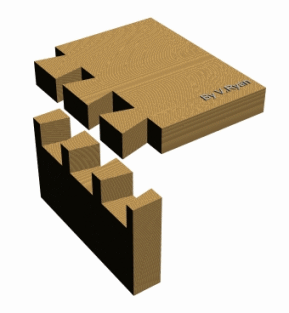Woodworking joints
 Corner Mortise and tenon joint:
Corner Mortise and tenon joint:
Corner mortise and tenon joints are used on tables and front legs or chairs where two rails are joined to a single legs at each corner. The end of the tenons are mitered where they meet inside the leg. The tenon is cut to fit the mortise hole exactly and usually has shoulders that seat when the joint fully enters the mortise hole. The joint may be glued, pinned, or wedged to lock it in place.
Forked mortise and tenon joints are found as the end of lock rails on large frame and panel doors. The gaps between the tenons should be no more than one third the width of the rail, this is so that it minimizes the amount of movement in them. The joint can be given extra strength by inserting a wedge at the end of the tenons.
Dowel joint:
 feet to round legs, it is easier to use dowel joints over mortise and tenon joints. Using dowels in furniture ensures an accurate fit as it is easy to locate the hole and with 2 dowels inserted into the joint it makes it really accurate. Dowel joints are also good because they come in all varieties of size from 4-25mm and have a grooved surface so that the glue can flow easily along the dowel after being inserted into the hole.
feet to round legs, it is easier to use dowel joints over mortise and tenon joints. Using dowels in furniture ensures an accurate fit as it is easy to locate the hole and with 2 dowels inserted into the joint it makes it really accurate. Dowel joints are also good because they come in all varieties of size from 4-25mm and have a grooved surface so that the glue can flow easily along the dowel after being inserted into the hole.
 Dovetail joint:
Dovetail joint:
A dovetail joint is mostly used in the corners on the backs of drawers, the tapered shape of the tails resists the forces applied to the joints when the drawer is being used. Apart from being a strong joint it can also be used for decorative purposes and to make something look nice. Dovetails consist of one piece having the tails and the other piece having the pins that fit into the tails.
Finger joint:
Finger joints are fairly easy to make as there are no dovetail styled angles involved in them. The large gluing gives the joint it's strength from each 'finger'. The finger joint can also be valuable when fixing tables and chairs and also can be used in such things as floor boards, timber roof and door construction. To visualize a finger joint simply interlock the fingers of your hands at a ninety degree angle
 feet to round legs, it is easier to use dowel joints over mortise and tenon joints. Using dowels in furniture ensures an accurate fit as it is easy to locate the hole and with 2 dowels inserted into the joint it makes it really accurate. Dowel joints are also good because they come in all varieties of size from 4-25mm and have a grooved surface so that the glue can flow easily along the dowel after being inserted into the hole.
feet to round legs, it is easier to use dowel joints over mortise and tenon joints. Using dowels in furniture ensures an accurate fit as it is easy to locate the hole and with 2 dowels inserted into the joint it makes it really accurate. Dowel joints are also good because they come in all varieties of size from 4-25mm and have a grooved surface so that the glue can flow easily along the dowel after being inserted into the hole.
Dovetail joint:
A dovetail joint is mostly used in the corners on the backs of drawers, the tapered shape of the tails resists the forces applied to the joints when the drawer is being used. Apart from being a strong joint it can also be used for decorative purposes and to make something look nice. Dovetails consist of one piece having the tails and the other piece having the pins that fit into the tails.
Finger joint:
Finger joints are fairly easy to make as there are no dovetail styled angles involved in them. The large gluing gives the joint it's strength from each 'finger'. The finger joint can also be valuable when fixing tables and chairs and also can be used in such things as floor boards, timber roof and door construction. To visualize a finger joint simply interlock the fingers of your hands at a ninety degree angle


No comments:
Post a Comment